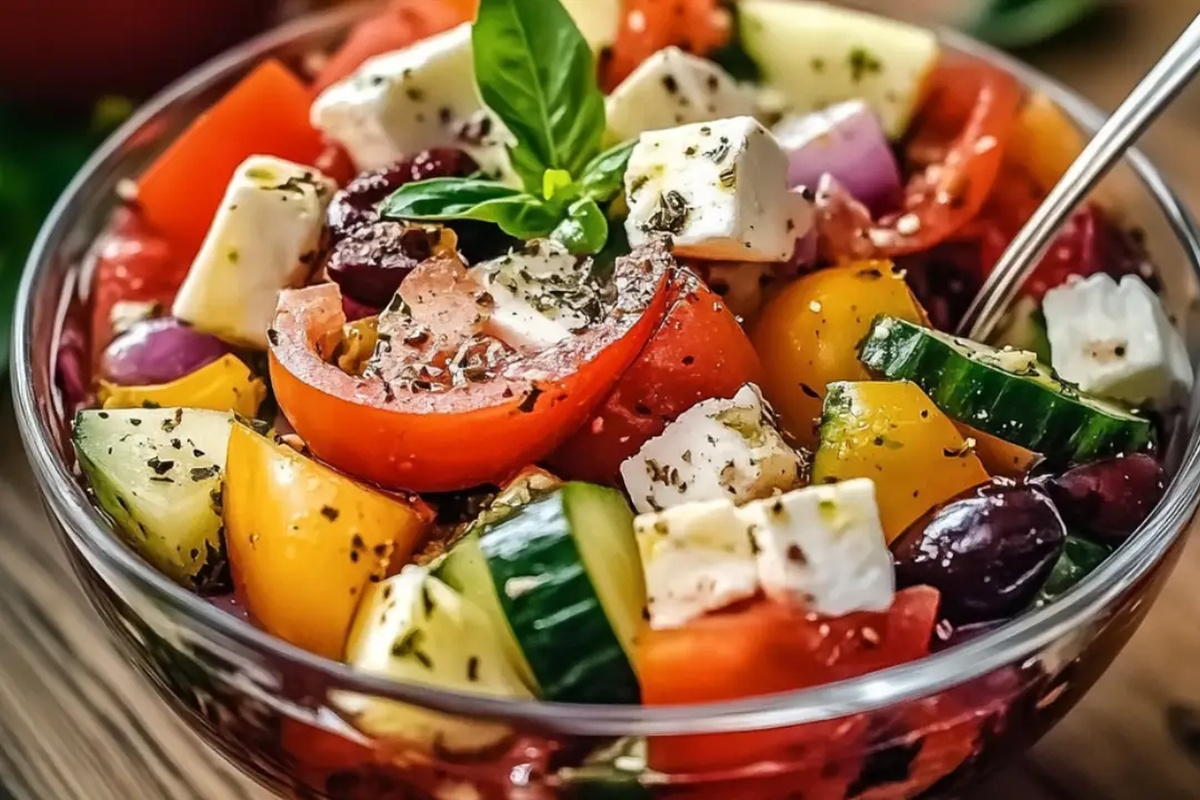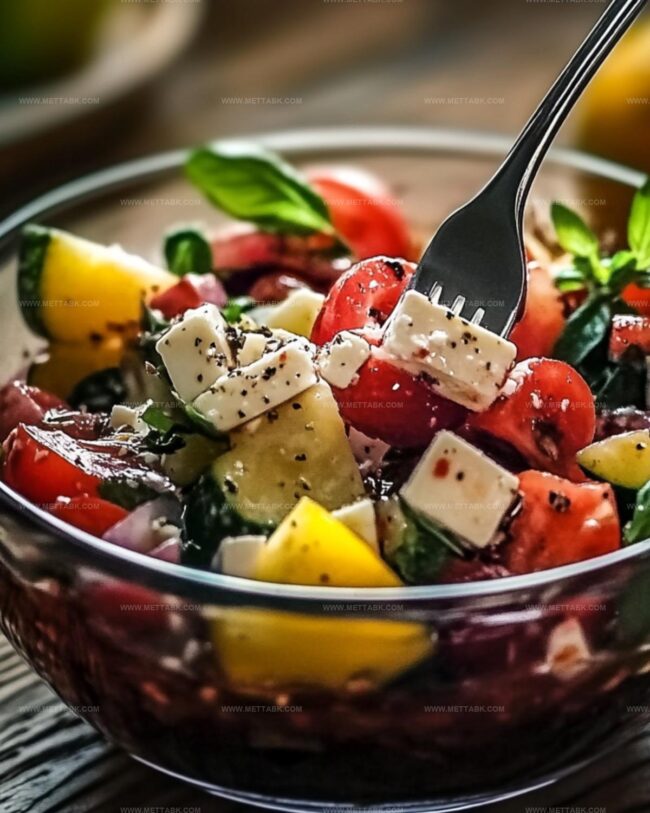Fresh Classic Greek Salad Recipe: Sunny Mediterranean Magic
Crafting the perfect classic greek salad requires a delightful blend of fresh ingredients that dance together on your plate.
Mediterranean flavors burst with vibrant colors and crisp textures.
Ripe tomatoes, cucumber slices, and briny kalamata olives create a symphony of taste.
Crumbled feta cheese adds a creamy tang that elevates every bite.
Chopped red onions bring a zesty punch to this traditional dish.
A simple olive oil and oregano dressing ties everything together with authentic Greek charm.
Dive into this refreshing salad that promises to transport you straight to the sunny shores of greece.
Variations on Classic Greek Salad
Best Pairings with Greek Salad
Savor Mediterranean Harmony: Perfect Pairings
Storing Classic Greek Salad Properly
Store leftover Greek salad in an airtight container in the refrigerator for 1-2 days. Keep dressing separate to prevent vegetables from becoming soggy.
Before serving chilled leftovers, drain any accumulated liquid and gently remix the salad to restore its fresh texture.
Remove salad from refrigerator 15-20 minutes before serving to allow ingredients to reach optimal flavor and reduce chilliness.
Avoid microwaving or heating this salad, as it will make vegetables mushy and compromise the crisp, fresh Mediterranean taste.
FAQs
The classic Greek salad includes tomatoes, cucumber, red onion, green bell pepper, Kalamata olives, and a block of feta cheese. The key is using fresh, high-quality vegetables and authentic Greek ingredients.
Red wine vinegar provides a tangy, sharp flavor that complements the rich olive oil and enhances the overall taste of the salad. It’s a signature component of authentic Greek salad dressing.
It’s best to prepare Greek salad just before serving to keep the vegetables crisp and fresh. If needed, you can chop ingredients in advance and dress the salad right before eating to maintain its texture.
Classic Greek Salad with Fresh Ingredients
Ingredients Needed for Classic Greek Salad
For the Base Vegetables:For the Cheese and Olives:For the Dressing and Seasonings:Preparation Guide for Classic Greek Salad
Step 1: Chop Fresh Produce
Grab a cutting board and slice ripe tomatoes into chunky wedges. Dice the crisp cucumber into bite-sized pieces.
Thinly slice red onion for a sharp flavor. Cut green bell pepper into slim strips.
Transfer all chopped vegetables into a spacious mixing bowl.
Step 2: Scatter Mediterranean Treasures
Sprinkle Kalamata olives generously across the vegetable mixture.
Place a whole block of creamy feta cheese directly on top of the salad. For easier serving, you can crumble the feta if preferred.
Step 3: Whip Up Zesty Dressing
In a separate small bowl, combine:Whisk ingredients until they blend smoothly and create a vibrant liquid.
Step 4: Dress and Toss Gently
Pour the prepared dressing over the vegetables and cheese.
Use a light hand to toss everything together, ensuring each ingredient gets a delicate coating without breaking the feta.
Step 5: Finish with Fresh Herbs
Sprinkle chopped fresh parsley or additional oregano on top for a burst of color and aroma.
Serve immediately alongside warm pita bread or as a refreshing side dish for grilled proteins.
Tips to Perfect Classic Greek Salad
Print
Classic Greek Salad Recipe
- Total Time: 15 minutes
- Yield: 4 1x
Description
Mediterranean summers dance through this classic greek salad, blending crisp cucumbers, juicy tomatoes, and tangy feta with kalamata olives. Refreshing herbs and zesty olive oil invite you to savor Greece’s culinary sunshine in every delightful bite.
Ingredients
Main Ingredients:
- 8 ounces (226 grams) feta cheese, cut into cubes or crumbled
- 3 ripe tomatoes, chopped into wedges
- 1 cucumber, sliced (or quartered if using a large cucumber)
- 1/2 cup (75 grams) Kalamata olives, pitted
- 1 green bell pepper, sliced
- 1 small red onion, thinly sliced
Dressing Ingredients:
- 2 tablespoons (30 milliliters) extra virgin olive oil
- 1 tablespoon (15 milliliters) red wine vinegar
- 1 teaspoon dried oregano
- Salt, to taste
- Pepper, to taste
Garnish (Optional):
- Fresh parsley
- Fresh oregano
Instructions
- Assemble crisp, fresh vegetables in a spacious mixing vessel, combining juicy tomatoes, cool cucumber, pungent red onion, and vibrant green bell pepper. Distribute ingredients uniformly with a delicate toss.
- Introduce briny Kalamata olives across the vegetable landscape, positioning authentic feta cheese either as an intact block or gently crumbled for convenient serving.
- Craft a zesty Mediterranean dressing by vigorously whisking extra virgin olive oil, tangy red wine vinegar, aromatic dried oregano, and seasoning with salt and pepper. Calibrate flavors to personal preference.
- Cascade dressing over the salad, ensuring a light, even coating. Tenderly integrate ingredients, preserving the structural integrity of the feta cheese.
- Elevate the presentation by sprinkling fresh parsley or additional oregano for enhanced aromatics. Serve immediately alongside warm pita bread or as an accompaniment to grilled proteins, capturing the essence of Greek culinary tradition.
Notes
- Slice vegetables uniformly to ensure balanced flavor and texture in every bite.
- Choose ripe, firm tomatoes and crisp cucumbers for maximum freshness and crunch.
- Soak red onions briefly in cold water to reduce sharp, harsh flavor and make them more palatable.
- Use high-quality extra virgin olive oil and authentic Greek feta for an authentic Mediterranean taste experience.
- Prepare salad just before serving to maintain vegetable crispness and prevent soggy texture.
- Allow salad to sit at room temperature for 10-15 minutes before serving to let flavors meld together naturally.
- Consider adding grilled chicken or chickpeas for a protein-packed vegetarian or light meal option.
- Store any leftovers separately to prevent vegetables from becoming watery and losing their vibrant texture.
- Prep Time: 15 minutes
- Cook Time: 0 minutes
- Category: Lunch, Dinner, Appetizer, Snacks
- Method: Blending
- Cuisine: Greek
Nutrition
- Serving Size: 4
- Calories: 235 kcal
- Sugar: 5 g
- Sodium: 520 mg
- Fat: 19 g
- Saturated Fat: 6 g
- Unsaturated Fat: 12 g
- Trans Fat: 0 g
- Carbohydrates: 7 g
- Fiber: 2 g
- Protein: 7 g
- Cholesterol: 25 mg



Nate Harper
Founder & Recipe Curator
Expertise
Single-Recipe Development, Farm-to-Table Cooking, Seasonal Menu Planning, Culinary Storytelling, Home Kitchen Innovation
Education
Cascade Culinary Institute – Central Oregon Community College
Certificate in Culinary Arts
Focus: Farm-to-table cuisine, sustainable cooking practices, and seasonal recipe creation.
Nate studied under experienced chefs who emphasized local sourcing, minimal waste, and building recipes from fresh, simple ingredients.
Nate Harper is the founder and creative force behind Make, Take, Bake. Raised in the wild beauty of Oregon’s high desert, Nate grew up surrounded by family gardens, farmers’ markets, and home kitchens that celebrated the seasons.
His early love for simple, honest food evolved into a professional passion when he attended Cascade Culinary Institute, where he sharpened his skills in creating recipes that are sustainable, satisfying, and made for everyday life.
Nate’s goal is to make cooking feel accessible, free of fuss, and full of flavor. He believes a single, thoughtfully built dish can stand alone, and sometimes even steal the show.